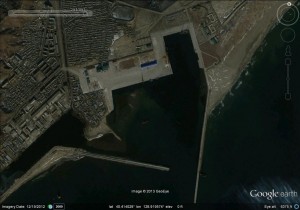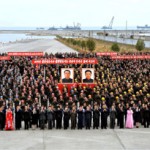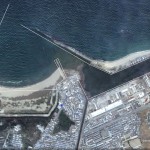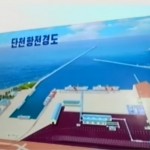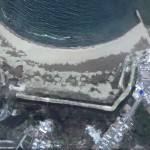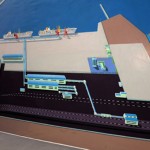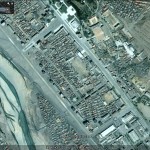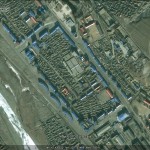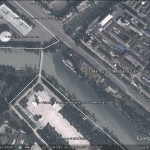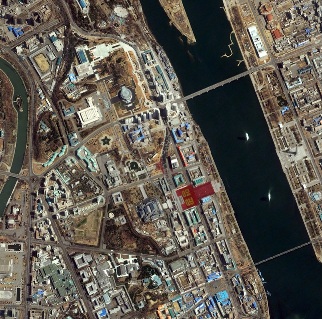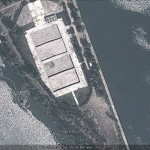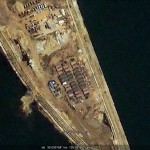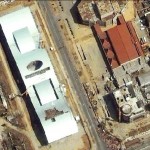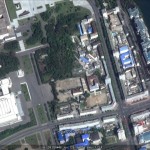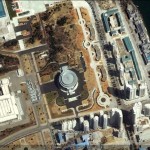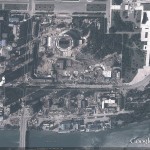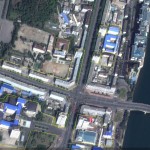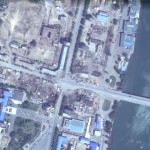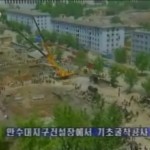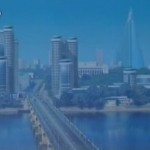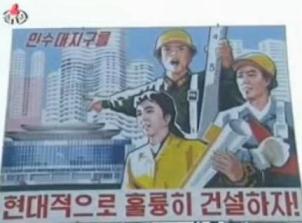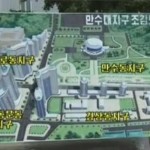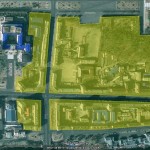UPDATE 6 (2013-7-1): The Daily NK reports the effort to construct 100,000 homes in Pyongyang has come to a complete halt. According to the article:
A troubled prestige project to build 100,000 new homes in Pyongyang has been brought to a complete halt under the rule of Kim Jong Eun, and buildings in some areas have fallen into a state of disrepair.
A source from the North Korean capital revealed to Daily NK on July 1st, “The 100,000 homes project has been at a complete halt since Kim Jong Eun took power, and on the outskirts of the city some buildings are half-built and collapsing into a state of disrepair.”
“In this area, people were evacuated in October 2009 so that the construction could commence,” the source went on. “But in many areas those buildings that were begun at that time are still not above the first floor.”
Homes planned as part of the project, which, according to state propaganda, was to form part of celebrations for North Korea’s becoming a “strong and prosperous state” by the 100th anniversary of Kim Il Sung’s birth in April 2012, were expected to feature in propaganda vis-a-vis Kim Jong Eun’s greatness.
However, the project has been plagued by electricity and material shortages from the beginning, sources say, and ultimately could not be completed. In some areas, the construction that did go ahead was poorly done and buildings have subsequently collapsed, which has caused deaths.
The source commented, “From Kim Jong Eun’s perspective the project was promoted so that he could say he was improving the people’s lives. But there were no raw materials and no power, and this caused poor construction; so ultimately it has just been abandoned.”
The North Korean authorities are only genuinely concerned about projects that offer short-term opportunities for public propagation of results, such as water parks and exercise facilities in downtown Pyongyang, the source went on to claim.
Meanwhile, the direct suffering caused by the failed project is falling primarily on those who were moved out of their homes in order for construction to start back in 2009. “In a number of cases, the Party ordered families to move out and live with others temporarily, and here we are, four years on, with multiple families living under one roof,” the source said, adding that the indignity of this is being compounded by mobilization orders calling on people without homes of their own to take part in downtown beautification and cleaning schemes.
I have have posted quite a bit of material on construction in Pyongyang in recent years. Here are some of the more relevant articles:
1. Mansudae Area Renovation No. 1
2. Mansudae Area Renovation No. 2
3. Kumgang Street
Read the full story here:
100,000 Homes Project Stopped Dead
Daily NK
Lee Sang Yong
2013-7-1
UPDATE 5 (2011-11-03): The Institute for Far Eastern Studies (IFES) reports on the status of Pyongyang’s residential construction effort.
North Korea Pushing Forward with the Project of Constructing 100,000 Housing Units in Pyongyang
In order to celebrate Kim Il Sung’s centennial birthday next year on April 15, 2012, the plan to build 100,000 private homes in Pyongyang is quickly underway. North Korea has announced its intension to upgrade Pyongyang into a city with over 100,000 homes. Pyongyang’s district of Mansudae is to build over one thousand units of high-rise apartments (77 stories), theaters, parks and other recreational facilities.
The KCNA reported on October 11, “For the next Day of the Sun, Pyongyang will be completely transformed.” The news added, “The construction of private homes has been in progress for five months and is at 70 percent completion. Mansudae District is rapidly changing with skyscrapers and high-rise apartments appearing throughout the city. Construction of theaters and service facilities are also in development.”
Facing Mansudae is [East] Pyongyang [area], another area in Pyongyang under enhancement and has secured over 17,400 square meters of land for multi-purpose service facilities and 9,660 square meters for a public outdoor ice rink. The KCNA elaborated, “The multi-purpose facilities encompass bathhouses, beauty salons, and other latest facilities of convenience. In the public outdoor ice rink, circular ice rink, bleachers and cultural recreational facilities will be built to provide necessary environment for people to enjoy various ice sports.”
Rungrado Recreation Ground is also reported to be rejuvenated with a variety of amusement rides and multipurpose water park. The water park will be equipped with wave pools, waterslides, and health pools.
In addition, Pyongyang is focusing on gardening and exterior beautification projects for private homes and public buildings, including installation of colorful tiles and paints as well as bright neon signs in the streets.
“The Development Project of 100,000 Housing Units in Pyongyang” went into effect since 2009 but talks of reducing the project to 20,000 homes surfaced when it was faced with funding difficulties. However, the original plan of building 100,000 homes has not faltered and appears to be in full swing.
Early this year on January 3, a public rally was held at the Kim Il Sung Square with over 100,000 people present. At that time, the homebuilding project of Pyongyang was announced in which “Pyongyang City will be equipped to enter the era of strong and prosperous nation in all sectors.”
In July 2008, the General Bureau of Capital Construction began a large-scale redevelopment project. Completed a year later on September 2009, 600 old homes mostly built in the 1960s were demolished and in their place an apartment complex with over 800 homes went up. This project received undivided attention from Kim Jong Il, Chang Sung-Thaek, administrative director of the Worker’s Party of Korea, among many other top officials of North Korea.
For North Korea, “The Development Project of 100,000 Housing Units in Pyongyang” has become a symbol of building a strong and prosperous nation.
Additional information:
1. Previous posts on the DPRK’s “2012 Kangsong Taeguk” policies can be found here.
2. Previous posts on “Construction” can be found here.
3. The Pyongyang’s university students are (mostly) involved in construction projects.
4. See photos of the construction by Ray Cunningham here.
UPDATE 4 (2011-7-23): Housing unit construction revised down?
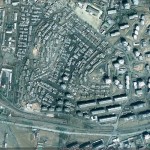
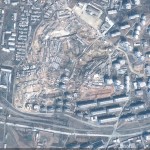
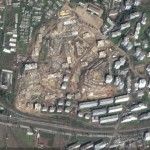
Pictured above (Goole Earth): New housing construction in Rakrang-guyok
For several years, the DPRK has been touting that it will build 100,000 new housing units by 2012. See here, here, and here for background.
This week, many South Korean news outlets reported that the DPRK had significantly downsized that number. According to Yonhap:
North Korea has dramatically cut its goal of building 100,000 houses by next year, a government source said Monday, amid the North being economically squeezed by the international community for its nuclear and missile programs for years.
After the North started the project in Pyongyang in 2009, as part of its plans to achieve a strong and prosperous country by 2012, the North cut the number of planned houses by 75 percent to 25,000. The year 2012 marks the centennial of the birth of Kim Il-sung, the country’s late founder.
The North, however, is continuing to repair a towering bronze statue of Kim and renovate around the Kumsusan Memorial Palace, where his embalmed body lies, the source said on condition of anonymity, citing policy.
Kim is the father of current leader, Kim Jong-il. The Kims are the subject of a massive personality cult that pervades almost every aspect of North Korean society.
Still, the North has embarked on a project to demolish buildings and facilities in central Pyongyang to make room for high-rise apartments, a theater and a park for senior officials.
The North has begun interior work on one of its landmarks, the 105-story Ryukyong Hotel, which stood unfinished in downtown Pyongyang for nearly 20 years due to a lack of capital.
In 2008, the North resumed construction of the skyscraper, but it appears unlikely for the project to be completed next year. It is believed, however, that the North will finish some floors for use.
The last time that KCTV mentioned the 100,000 housing unit goal was on May 26, 2011…nearly a month ago. I will keep up to see if it is ever mentioned again. I would not hold my breath waiting for a lower number to be announced, however.
Using satellite imagery of Pyongyang, I can see appx 200 residential buildings under construction. They are mostly concentrated in Hyongjesan-guyok. On average, each of these buildings would have to contain 500 housing units to reach 100,000. This is not possible given the dimensions of the buildings we can see. Additionally, most of these facilities are a long way from being completed. With a goal of 25,000, that would mean new buildings on average would only need to contain 125 units…a much more reasonable number.
In terms of residential construction, the government now seems to be focusing its efforts primarily on completing the second phase of the Mansudae Street renovations in time for Kim Il-sung’s 100th birthday. See here and here.
The prestigious units (visited by Kim Jong-il) that have been completed are all in Pyongyang’s Central District: Near the Potong Gate (Google Maps), Near Haebang Hill (Google Maps), and behind the Central Market (Google Maps). I should point out, however, that these are not the only buildings to be completed. Other less-prestigious buildings have been completed and occupied. Also, many villages (ri, 리) outside the capital are being upgraded and provided new facilities. I am not sure what the procedure is for deciding which villages receive new homes, but it can’t be random. Being located next to a major highway seems to be an important variable (keeping up appearances). I am also unsure what the DPRK does with all of the displaced residents. Are they going somewhere else to live with their families? Are they living in temporary shelters?
The Daily NK and Choson Ilbo also covered this story.
UPDATE 3 (2011 -7-5): Several days ago, Yonhap reported that the DPRK had quietly reduced its goal of building 100,000 housing units by 2012. So of the 200+ buildings that are currently under construction, which projects are priorities? Mansudae Part II for sure (see here and here). But what else? There are many construction sites that were launched well before the second renovation of the Mansudae area was begun, and the deadline for completion is rapidly approaching.
Well North Korea recently broadcast a propaganda television show touting Pyongyang’s housing construction (along with quite a lot of singing). I was able to match up this North Korean television footage with satellite imagery of Pyongyang construction sites to help answer this question. Given the amount of propaganda being used to promote these particular developments, I would say the following three are also 2012 priorities:
Ryongsong-guyok, Chonggye-dong (룡성구역, 청계동)
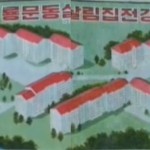
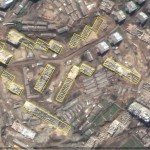
Click on images for larger versions. See in Google Maps here.
Hyongjesan-guyok, Sopho-2 Dong (형제산구역, 서포2동)
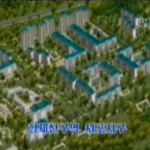
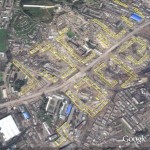
Click on images for larger versions. See in Google Maps here.
Rakrang-guyok, Tongsan-dong (락랑구역, 동산동)
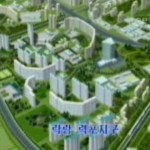
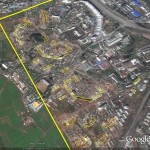
Click on images for larger versions. See in Google Maps here.
The DPRK also recently hosted an architecture expo in Pyongyang. I have uploaded a video of the event to YouTube, and you can watch it here. I was able to match up some of the projects (though not all) with current satellite imagery. Aside from the renovation of the Ryugyong Hotel, there is no publicly available satellite imagery showing that these projects have been launched.
Hyoksin Area (혁신)
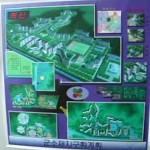
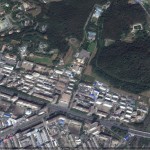
Ryugyong Area (류경)
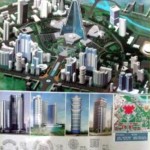
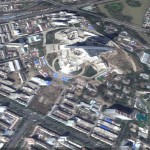
Additional Informaiton
1. So Marcus Noland was right. They want tall buildings.
2. For several years now I have been tracking construction in Pyongyang. See here, here, here, here, here, here, here, and here.
UPDATE 2(2010-7-28): According to the Daily NK the construction has come to a halt:
The construction of 100,000 homes in Pyongyang has been put on hold due to a lack of cement. According to a Daily NK source, the project is around 40 percent complete.
The year’s aim is to finish 35,000 households out of the total 100,000 planned for construction. Work is due for completion by 2012.
The North Korean authorities had planned to construct 20,000 houses along the railroad from the Ryongseong-district via Seopo in the Hyeongjesan-district to the Ryeokpo-district and 25,000 houses in the center of the city. The schedule for laying the foundations has been set for September this year with plastering and interior works running until the end of the year.
The frame work of the houses, expected to finish by September, have been suspended due to lack of cement and other materials. A source commented that, “It was planned that general construction of frame works would finish in September but exterior construction has been halted due to a lack of materials.”
The North’s authorities have attempted to supply materials through the Sangwon Cement Complex, the Chollima Steel Mill Complex and other factories across the country. Annual production of cement in North Korea amounts to 6.4 million tons, approximately 12 percent of South Korea’s. However this is not enough to fuel general construction of key facilities such as social infrastructure and military facilities.
Large scale power plant constructions such as the Heecheon Power Plant combined with the building of 100,000 houses in Pyongyang have meant the shortage of cement is particularly acute.
Last year the North established the Pyongkeon Development Investment Group, attracting 320 million dollars of foreign capital. According to the plan submitted by the Group, 300,000 tons of cement are needed for foundation work in March alone.
Chosun Shinbo, the publication of the Chongryon (General Association of North Korean Residents in Japan), reported the construction of 35,000 houses was started in September last year. Since then, old houses in the districts have been torn down and neighborhoods rezoned. In March, the foundations of the houses were laid and the exterior frame work was built but construction has made little progress throughout June due to low cement levels.
The 100,000 household construction project in Pyongyang has been led by Jang Sung Taek, Director of the Ministry of Administration of the Workers’ Party, later appointed as the Vice-chairman of the National Defense Commission earlier this year at the Supreme People’s Assembly.
A source reported that, “Jang Sung Taek ordered foreign currency earning organizations to procure cement and that even selling coal should be considered.”
North Korea launched the state project to construct 100,000 houses in Pyongyang as a symbol of completion of the strong and prosperous state as part of a three-year campaign. Additionally, this project has been advertised as an achievement of the successor, Kim Jong Eun. If the plan fails then it will be a blow to the succession. If construction is suspended completely in advance of the Delegates’ Conference, happening in September, the image of Kim Jong Eun could be damaged.
UPDATE 1 (2010-5-2): Pyongyang’s 2012 renovations
Barbara Demick, Los Angeles Times correspondent and author of the very interesting and enjoyable Nothing to Envy, was the first western journalist to write about Pyongyang’s construction boom and the DPRK’s goal of achieving a strong and prosperous nation by the time of Kim Il-sung’s 100th birthday in 2012. The article is a bit dated, but I thought it would be fun to go back and point out all of the construction projects she mentioned in Pyongyang (plus a few more).
Below are some blurbs from Demick’s article supplemented with satellite imagery:
Blurb 1: “Yet these days, high-rise apartments in shades of pink are taking shape near the Pueblo, the American spy ship captured in 1968 and still anchored in the river. A tangle of construction cranes juts into the skyline near Pothong Gate, a re-creation of the old city wall. About 100,000 units are to be built over the next four years.”
I have already blogged about the new housing near the Potong Gate (see here). Here is the housing near the Pueblo (click on images for larger versions):



The dates of the pictures are 4/6/2005, 11/12/2006, 1/28/2009). The original Los Angeles Times story had a picture of the completed building but that does not appear to have been archived. Kernbeisser got a photo of the building under construction.
Blurb 2: “But South Korean companies and individuals have mostly ignored the political chill. Among the biggest players here are a unit of the Hyundai conglomerate, which operates the resort where the shooting occurred, and companies affiliated with the Rev. Sun Myung Moon’s Unification Church, which also runs a car assembly plant in North Korea [Pyonghwa Motors]. The church last year completed work on what it calls the World Peace Center, behind the Potonggang Hotel, also owned by church affiliates.”
You can see a satellite image of Pyonghwa Motors plant near Nampo here.
Here is an image of the Potonggang Hotel.
Here is the World Peace Center.
Blurb 3: A Chinese company, meanwhile, is renovating the No. 1 Department Store in the heart of downtown.
Here is an image of Department Store No. 1.
Blurb 4: The Taedonggang Hotel, where Soviet dignitaries stayed in the 1960s and which burned down in 2002, is being restored as a five-star hotel. The Pyongyang Grand Theater, which stages revolutionary operas, is under renovation. The oldest and most elegant of the city’s movie theaters, the Taedongmun Cinema, was restored over the summer and used for screenings at the Pyongyang International Film Festival, which opened here last week.
Here are satellite images of the Taedonggang Hotel reconstruction:




Kernbeisser offers a great visual contrast between the hotel’s past and future. Click the links for images.
Here is an image of the Pyongyang Grand Theater under renovation.
Of course these places only scratch the surface of construction work in the DPRK in the last few years. I started to make a list of construction and refurbishment projects, but it got very long very fast. Since I have other things to do on this lovely Sunday afternoon you will have to wait for me to get around to it at a later date.
ORIGINAL POST (2009-10-20): According to KCNA:
General Secretary Kim Jong Il went round newly-built apartment houses in Mansudae Street.
…
Saying that the newly-built apartment houses of new styles in the street are the most modern ones which fully reflect the plan and intention of the Party to provide the people with the best living conditions, he added that those apartment houses in the street serve as a model and standard for building dwelling houses to be used by all the people in a great prosperous and powerful nation.
…
He said that it is necessary to build in Pyongyang modern flats for 100,000 families, houses similar to those apartment houses standing in Mansudae Street, in a matter of a few years as an immediate task.
He expressed great expectation and conviction that all builders of the capital city would create new “Pyongyang Speed” in the era of Songun in the construction of the capital city and usher in “an era of prosperity of Pyongyang” in the new century just as the people created the world-startling “Pyongyang Speed” in the 1950s by building a flat for a family in just 14 minutes true to the Party’s policy of prefabricated construction after the war and as the people in the 1970s and the 1980s opened up “an era of prosperity of Pyongyang” by building many modern streets and great monumental edifices in a matter of 15 years and thus demonstrate once again to the whole world the revolutionary spirit of the service persons and people of the DPRK, successors to the great history and tradition.
The goal of constructing 100,000 flats has been repeated in KCNA since then: December 5, 2009, January 22, 2010, February 6, 2010, March 18, 2010. In KCNA they have been careful not to declare a specific deadline for completion, but (thanks to a reader) in the monthly magazine Korea they have set Kim Il-sung’s 100th birthday in 2012 as the date.
I have blogged about and mapped the construction on Mansudae Street. You can see the inside and outside of these buildings here.
So where will all these flats be located, and what does the construction look like? Below I have posted a GeoEye satellite image from Google Earth which highlights the residential construction areas (in yellow).
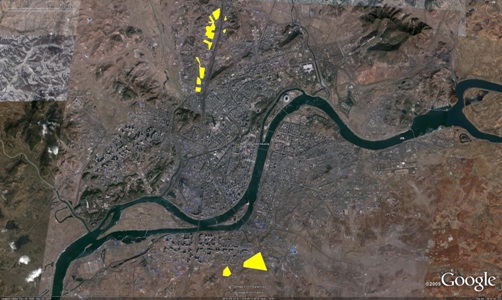
Click image for larger version
So it looks like the majority of the residential construction will be located in Hyongjiesan-kuyok (형제산 구역) in the north and Rakrang-kuyok (락랑 구역) in the south.
According to the June 7, 2010 DPRK evening news, it looks like soldiers are involved in the construction. No surprise there. It is unclear how many are involved. Based on the image below I will let the “professionsals” determine which brigades are involved in the work:
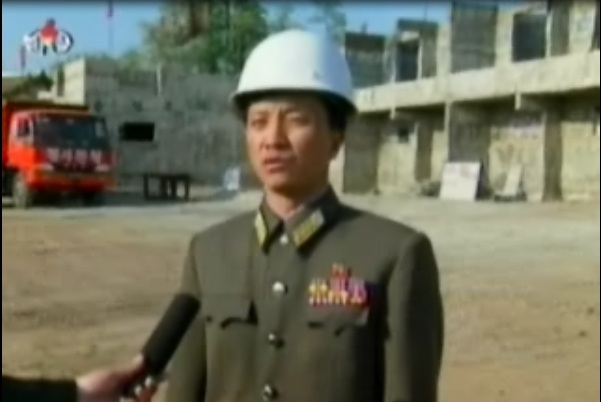
According to the same evening news broadcast, it looks like the workers have reached the second floor of at least one of these construciton areas.
As with the post-explosion reconstruction of Ryongchon (see images here), the North Korean government is tearing down traditional, single-family houses and building “modern” high-rises in their place. At this point the status of the former residents is unclear. Have they been moved into temporary housing (assuming they will get new flats once they are completed) or have they been permanently relocated to make room for the 100,000 lucky families? (This method of residential development reminds me of Ceauşescu’s Romania.)
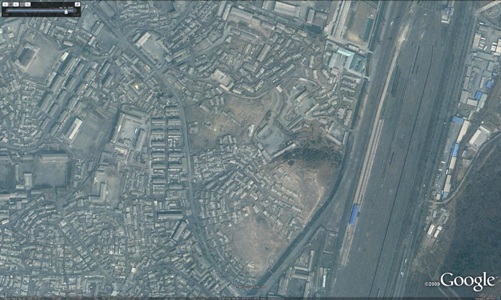
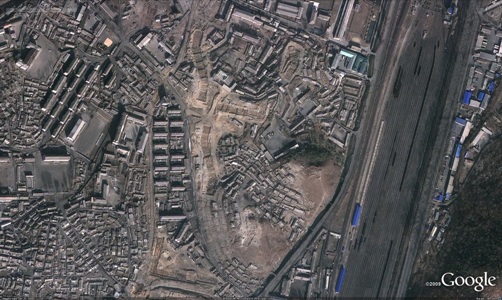
Click images for larger versions. Top: April, 10, 2009 Bottom: December 20, 2009
Looking at the urban geography of the area I get the feeling that Jane Jacobs would be very disappointed.
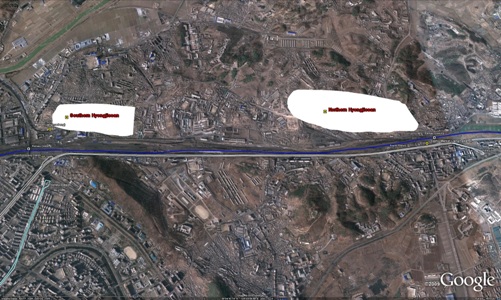
Click image for larger version (rotated 90 degrees – so “north” is on the right, “south” on the left)
It seems like the new residents of the northern part of Hyongjiesan will be de facto residents of Sopho even though the railway line makes them separately distinct neighborhoods. Sopho offers the closest train station and market. Residents at the southern end of the Hyongjiesan housing project will need to use a smaller market near the Sopyong Train Repair Factory (See satellite image here) and the West Pyongyang Railway Station. Although the railway line defines the eastern border of Hyongjiesan District as of today there are only two places where commuters may cross over the tracks—at the West Pyognyang and Sopho Railway Stations. The distance between these two railway crossings is 3 miles (4.82 kilometers).
As of now, it appears there is little industry and few schools this far out of the city, so it is probable that most of the residents will be commuting into town. However, none of the new housing is metro accessible. Sopho receives bus service and the West Pyongyang Station receives bus and tram service. However the bus from the West Pyongyang Station to the Sopho Station lies to the east of the new housing and is separated by three miles of railway. Adding more bus stops between the two stations and providing more railway crossings from the east side to the west side of the tracks would be very helpful in reducing the amount of walking residents would need to take. Somehow, I do not think that will happen.
As for the buses, with only one line to service 100,000 families look for them to be crowded. It is possible that a commuter rail-line could easily transport workers to the center of town (like in Hamhung), but that might be wishful thinking at this point.
And finally, although the 100,000 families that do end up living in these homes will theoretically enjoy newer, higher-quality housing, their movements in and out of the buildings can be more easily monitored by inminban (인민반) than those in the single-family homes. In the traditional single-family homes there are multiple avenues to enter and leave the neighborhood, but when everyone uses the same door to enter and leave, residents’ activities can be more easily monitored.
So why not build more high-rises in the center of town where people actually work? These kinds of planning snafus are reflected in most socialist cities and are (unfortunately) predictable. To learn more about the urban economics of planned cities, I recommend not just Jane Jacobs but also “The Urban Dimension of the North Korean Economy: A Speculative Analysis” by Bertrand Renaud. Read his full chapter here. Lots of good stuff from them.



















